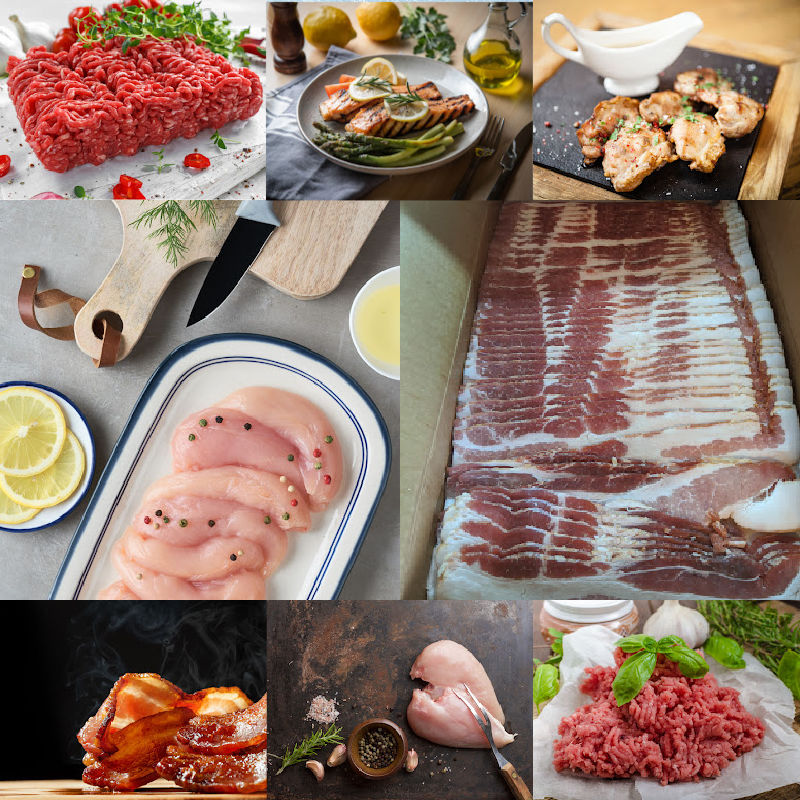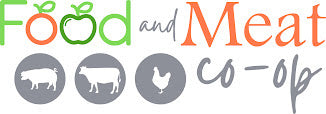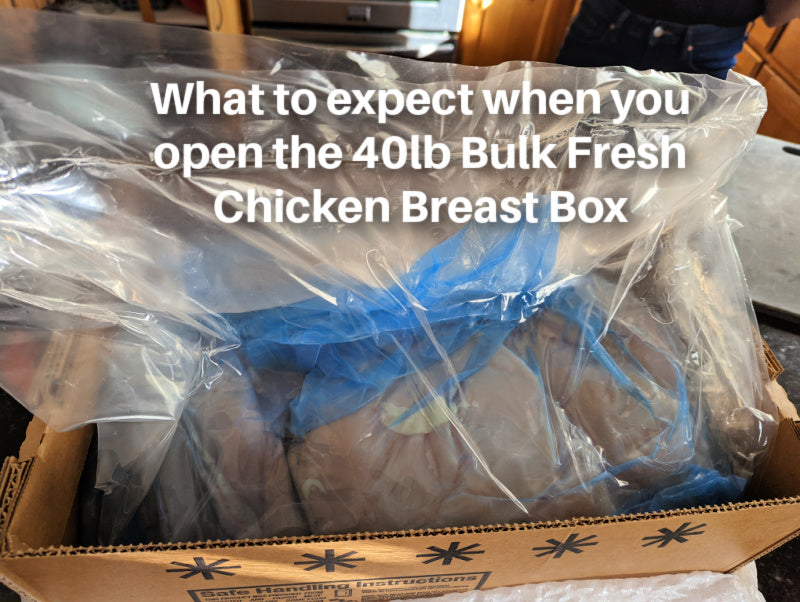Y'all know we have crazy good deals on crazy good quality meats and foods.
And if you have been with us long, you will know that one of the "favorited" items is the 40lb case of boneless, skinless, natural, cage-free chicken breast (free of steroids, antibiotics and no added hormones).
It's basically the best chicken breast on the market aside from buying certified organic or raising your own.

We offer our chicken in several different forms and types, but the majority "flock" (see what I did there?) to the fresh, minimally processed 40lb case.
As such, it is a GREAT product. So it is juicy and a bit slimy. Raw chicken is honestly one of the most unappetizing food experiences in it's raw form.
Cooked chicken is amazing, healthy, versatile and everything in between.
But Raw is Blah!
However, It is important to us that you get chicken that is as close a backyard experience as possible and thus we bring it in in the bulk packaging with minimal processing, saving you the most money and giving you a chance to finish the processing yourself and package how you would like (canned, frozen, freezer meals, cooked, shredded, diced, whatever your fancy).
I do not like dealing with raw chicken, but I have personally purchased chicken this way for 11 years. This has been the primary and only way I have bought chicken and so I have grown accustomed to what is expected, but I realize that not everyone is and would probably appreciate a quick tutorial on what to expect when you open your chicken box!
What does minimally processed mean?
THIS minimally processed chicken is hand trimmed from start to the minimum finish. That means that the skin and bones have been removed, but the breasts are still butterflied (what's that?!? We will get to that next) and may still have some cartilage and minimum bones (they try to remove all) and some fats still attached. So you have to do the deeper trimming.
They are doing the minimal amount in processing and it is all done by hand.
Check out this video on unboxing a 40lb chicken breast case:
Here's a cartilage piece example of what you can expect in some of the breasts that will need to be cut out when you are preparing your chicken at home.

Ok, so now next question...what does Butterflied Breasts mean?
Well, in case you didn't know...chickens have 2 breasts 🤪 and there is a breast bone that connects them, and they will cut that out during the first level minimal processing stage, but it still leaves them butterflied with a softer cartilage strip connecting them. I personally cut out that center cartilage and cut them apart at the same time. Some people will freeze and cook them with that together still.
Here's what that looks like (the pile above is chicken I am dicing into homemade grilled and seasoned nuggets for the freezer - a family fav around here):

Finally, the last thing to expect is that there will be some fats to trim. Some people like to keep this for broth or keep it attached, some like to trim it. But expect to have some fats to deal with.
That looks like this:

With this extra trimming, you will be left with a few pounds of trimmings in a 40lb box depending on how much you trim off. The trimmings make great broth as an FYI!
Here's a short video showing the process of trimming each butterflied breast when you take them home (each box will have between 18-22 butterflied breasts. They are packed by weight, not quantity and natural chickens have different sizes).
>>>Trimming Chicken Example Video HERE<<<
Now the "can happen on occasion but not often" things you may come across.
Like I said, I have been buying chicken this way for 11 years. I get a case a few times per year.
The three issues above I will encounter in every box (not every breast).
However, there are a few scenarios that do happen that I have seen every once in a while.
1. Feathers. It happens. Feathers are crazy and can get everywhere - like a glitter bomb. I have seen a few in boxes on occasion. It reminds me that is is fresh from the farm. But when you are used to getting chicken in it's multiple processes and long supply chain and frozen, defrosted and then sold as fresh in the store, feathers are that reminder as weird as it is.
2. More bones. Humans are doing the first level of trimming, so besides the cartilage bones, I have occasionally found other bones that were missed during the processing process, but it is rare. And I just simply cut them out.
3. Bruising. I will get what looks like a bruise on the chicken. This can happen for a number of reasons, like hitting a blood vessel before fully bleeding out, or if a bone breaks before it is cut off or a bone broke right before it was slaughtered. That happens. Because we are dealing with real food and not fake or perfect, bruising can happen many different ways, but it is still fine to eat and would be a waste to not. It just doesn't look as appetizing.
4. Scalding. Sometimes, you may come across pieces that look slightly cooked and shredded. This is due to scalding during the initial stage of processing. Scalding is a safe, standard step in poultry processing where chickens are briefly dipped in very hot water to loosen feathers for easier removal. It may slightly alter the skin's appearance, giving it a shredded or slightly cooked (whitish or yellowish harder surface) but doesn't affect safety or quality. The process is tightly regulated, and cooking the chicken to 165°F eliminates any bacteria, ensuring it's perfectly safe to eat, which you should always do even in perfect looking chicken.
Here is an example of scalding:

These issues above are not super common, but they do happen. Remember, you are buying MINIMALLY processed. That means that only the first level of processing has happened. It also ensures the freshest and as close to farm as you can get without dealing with the hardest first level of processing. So it's all a blessing, but requires a bit of work and occasional feather, bones, bruising or scalding.
Here's the truth for me.
For years, I could not even handle a raw whole chicken. It would gross me out so badly. I could barely handle breasts. But when I started buying fresh from the source, I realized it was such a much better quality and it saved me so much money, so I have dealt with it since and find this is much better to put this on a plate in the end.
So it is all worth it!
In the end, this is a crazy amazing way to purchase chicken that you are getting super fresh! Like just a few days from being processed.
It really doesn't get better than this in terms of pricing, freshness, quality and more!
And...if you don't want to deal with any of the above, our meat cutters will take care of all of it for you in our prepped breast box.
They take your box of fresh chicken into our USDA certified meat cutting room and will trim it, split the breasts, cut out cartilage and more fats and vacuum seal it in a 2-breast pack so you end up with about 22 packs of 2-breast packs. They will then deep freeze it and when you get it, all you have to do is put it in your freezer!
>>>>>See the Prepped Breast HERE<<<<<

Here's what that final box looks like when you pay extra to have our meat cutters trim, vacuum pack in sous vide bags and flash freeze. All you have to do is put it in the freezer! Each case ends up with 19-22 packages with 2 breasts per package.
You Might Also Like:

How to Use 40 lbs of Chicken Breast in Bulk and Restock Every Three Months







7 comments
Eva,
We source from Koch Foods (pronounced Cook) that does all of the processing of the chicken that comes from the midwest. Koch processes the chicken from 350 small poultry farms in the midwest. Each of these farms have a list of requirements for farming and raising practices including no steroids, no added hormones, antibiotic free, cage-free and humane practices.
When it says cage free does it mean roaming around on the grass like pasture raised or still all crowded in a building and they’re not in crates. I’ve seen large buildings with so many chickens you can’t even walk. They were dead chickens underneath all the live chickens because there were so many in there. Is there any way of finding out the forms and getting some some knowledge of how they handle the chickens and what they feed them
What makes some chicken breasts extra large? I have purchased in the past and they were really big and thick.
Where exactly are the chicken raised
I have not done this before. Where in Southern Utah would the pick up be?